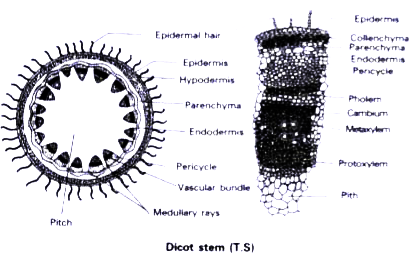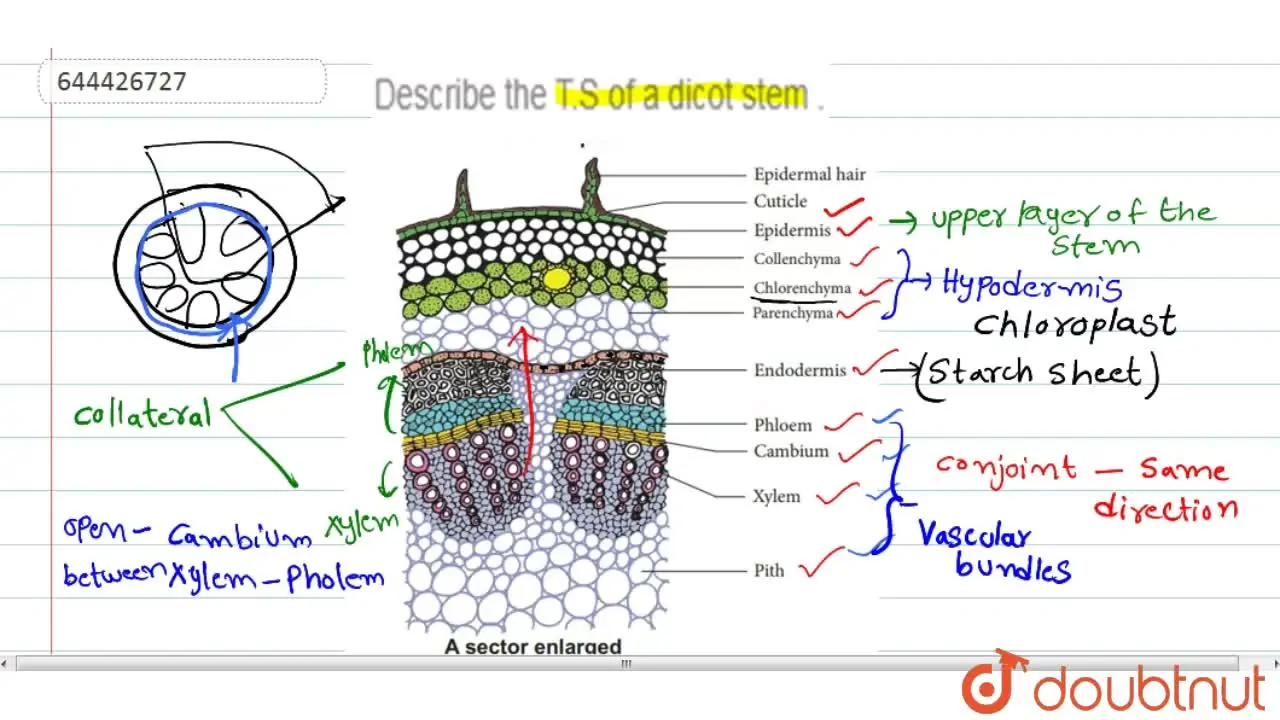Describe the T.S of a dicot stem . Solution in Telugu
The structure of young dicot stem can be clearly understood by observing the transverse section of stem of Helianthus annus (sunflower ).It shows three major zones , namely epidermis , cortex and stele .
1. Epidermis : It is the outer most layer of rectangular or tubular cells arranged compactly without any intercellular spaces . On outer surface of epidermis , a waxy layer called Cuticle is fund . The cuticle is chemically composed of a substance cutin . The cell wall of epidermis also show the presence of cutin Stomata are present in the epidermis . Multicellular trichomes develop on the epidermis . The cuticle and the trichomes check the evaporation of water and protect the stem from high temperature .
The epidermal layer gives protection to the inner tissues and also prevents teh evaporation of water and protect the stem from high temperature .
The eidermal layer gives protection to the inner tissues and also prevents the evaporation of water from the plant body . through stomata , the epidermis allows the exchange of gases and promotes transpiration . Trichomes prevent entry of pathogens .
2.Cortex : The part extending between the epidermis and the stele is known as cortex . The cortex is smaller than the stele . It shows three sub - zones , namely , (i) Hypoderms (ii) general Cortex and (iii) Endormis .
(i) Hypodermis : This is the outermost part of cortex and composed of 3-6 rows of collenchymatous cells . It is found beneath the epidermis and helps in providing tensile stregth (elasticity ) to the stem . The cells are arranged compactly without intercellular spaces and show excessively thickened corners . The cells are filled with active vacuolated cytoplasm possessing chloroplasts . thus , the hypodermis also helps in the assimilation of food materials . It also gives mechanical strength .
(ii) General Cortex : It is found beneath the hypodermal layer layer and is made up of 5- 10 rows of thin walled , living parenchyma cells with or without intercellular spaces. these cells may be isodiametric or oval or spherical . the outer layers of cells contain chloroplasts and in the inner layers leucoplasts are found . the general cortex is primarily concerned with the assimilation and storage of food materials .
(iii) Endodermis : The inner most layer of cortex is called endormis . The cells are barrel shaped , compactly arranged without intercellular spaces . the endodermis cells contain vacuolated protoplasts and show starch grains . So it is also known as Starch Sheath .
3. Stele : The central conducting cylinder is called the Stele .It occupies a major part of the stem . It is composed of 4 parts .
(i) Pericycle (ii) Vascular bundles (iii) Pith or Medulla and (iv) Medullary rays .
(i) Pericycle : It is present in the form of a discontinuous ring and is made up 3-5 rows of the thick walled , dead , lignified cells which gives mechanical strength to the stele . it appears as semilunar patches of sclerenchyma above the vascular bundles with intervening masses of parenchyma .
(ii) Vascular bundles : About 15 - 20 vascular bundles are arranged in the form of a ring . this arrangement is called eustele . Each vascular bundle is wedge or top shaped . In the vascular bundles xylem and phloem are arranged on the same radius . A meristematic layer of cells called cambium is present in between the xylem and phloem . So they are called conjoint , collateral , open vascular bundles .Xylem is at lower side and phloem at the upper side of the vascular bundle .
Xylem consists of vessels and xylem parenchyma . There may be few tracheids and xylem fibres . The metaxylem is towards the pericycle and protoxylem towards the pith . This is called endarch xylem . Phloem consists of sieve tubes companion cells and phloem parenchyma . Xylem and phloem are vascular tissues which conduct water , mineral salts and organic solutes respectively .
(iii) Medulla : It is the central part of the stele and filled with thin walled parenchymatous cels , showing intercellular -spaces . It is well -developed , extensive and occupies a large part of the stele . The chief function of the medulla is to store food materials .
(iv) Medullary rays : The cells of the medulla extend to the periphery in between the vascular bundles . These cells are horizontal rows of thin walled , living and elongate radially , forming primary medullary rays .
The medullary rays connect the stele with the cortex and are helpful in lateral conduction .
 .
.
Related Playlists
- BOOK - VIKRAM PUBLICATION ( ANDHRA PUBLICATION)CHAPTER - HISTOLOGY AND ANATOMY OF FLOWERING PLANTS EXERCISE - TEXTUAL EXERCISES3videos
HISTOLOGY AND ANATOMY OF FLOWERING PLANTS
- BOOK - VIKRAM PUBLICATION ( ANDHRA PUBLICATION)CHAPTER - HISTOLOGY AND ANATOMY OF FLOWERING PLANTS EXERCISE - IMPORTANT QUESTIONS7videos
HISTOLOGY AND ANATOMY OF FLOWERING PLANTS
- BOOK - VIKRAM PUBLICATION ( ANDHRA PUBLICATION)CHAPTER - HISTOLOGY AND ANATOMY OF FLOWERING PLANTS EXERCISE - SHORT ANSWER TYPE QUESTIONS10videos
HISTOLOGY AND ANATOMY OF FLOWERING PLANTS
- BOOK - VIKRAM PUBLICATION ( ANDHRA PUBLICATION)CHAPTER - ECOLOGY AND ENVIRONMENT EXERCISE - IMPORTANT QUESTIONS45videos
ECOLOGY AND ENVIRONMENT
- BOOK - VIKRAM PUBLICATION ( ANDHRA PUBLICATION)CHAPTER - LOCOMOTION AND REPRODUCTION IN PROTOZOAEXERCISE - Important Questions13videos
LOCOMOTION AND REPRODUCTION IN PROTOZOA
Similar Questions
Name the various kinds of cell layers which constitute the bark .
02:51View SolutionWhy are xylem and phloem called complex tissues?
03:22View SolutionState the location and function of different types of meristem.
View SolutionDefine the term "ecology" and its branches.
10:54View SolutionList any two differences between a flagellum and a cilium.
02:54View SolutionT.S. of stem of Cucurbita can be indentified from the T.S. of sunflower stem by the presence of
03:31View SolutionDescribe the vascular bundles of a dicot stem.
07:24View SolutionCompare T.S. of monocot and dicot stem with the help of well labelled diagrams only.
08:42View SolutionDescribe internal structure of (sunflower stem) of young stem of dicot plant.
03:03View SolutionDescribe briefly the secondary growth in a dicot stem ?
View SolutionDescribe the T.S. of dicot stem.
View SolutionWith the help of a neat labelled diagram, describe T.S. of dicot stem (sunflower).
05:41View SolutionDescribe the T.S of a Monocot stem .
View SolutionDraw the diagram of the T.S. of Dicot stem.
View SolutionDraw a well labelled diagram of T.S of dicot and monocot stem.
View Solution


